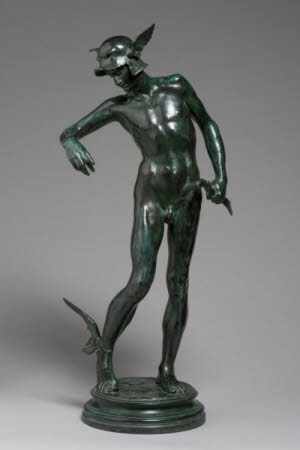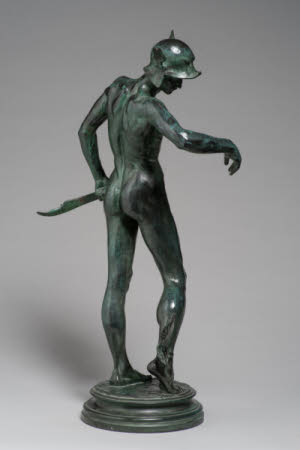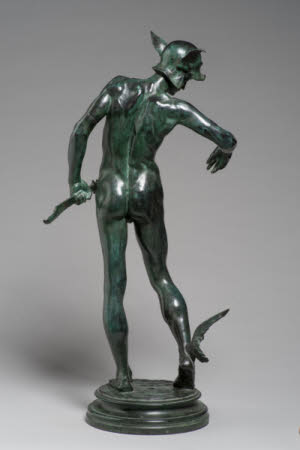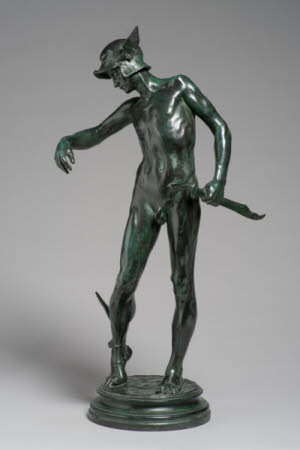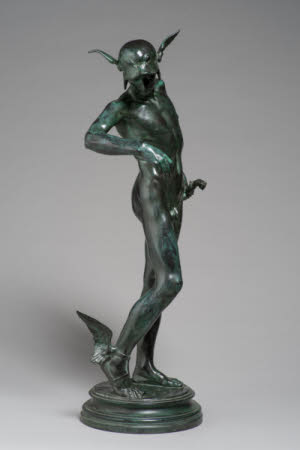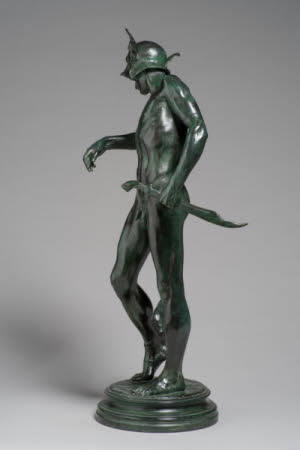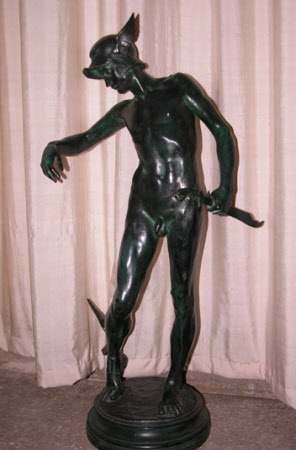Perseus Arming
Sir Alfred Gilbert RA (London 1854 – London 1934)
Category
Art / Sculpture
Date
1882 (model) - 1901 - 1920 (probably cast)
Materials
Bronze
Measurements
713 x 400 mm; 225 mm (Diameter)
Place of origin
Rome
Order this imageCollection
Anglesey Abbey, Cambridgeshire
NT 515027
Summary
Bronze, Perseus Arming, Sir Alfred Gilbert (1854-1934), modelled Rome, 1881-2, possibly cast Brussels or London, c.1901-20. A bronze sculpture depicting the figure of the mythical Greek hero Perseus, naked except for a winged helmet and for a winged sandal that he has just attached to his right foot, which is slightly raised, and towards which Perseus looks. In his left hand he holds by its blade a falchion sword. Mounted on a circular bronze base. Model made in 1881-82, date of this cast unknown. Arms separately cast, this is especially apparent with left arm, where the patches for the fastening rivets may also be seen. Perseus was a Greek hero, the son of Zeus, the king of the Gods, and Danaë, who was conceived when Zeus visited Danaë in a shower of gold. As a young man, Perseus obtained winged sandals and a helmet that rendered him invisible, permitting him to approach the monstrous Gorgons and to cut off the head of Medusa, which he put into a wallet. He was able later to use the head of Medusa to kill the sea monster that was threatening Andromeda, whom he subsequently married. Gilbert’s bronze figure probably represents the hero at the point when he was preparing to do battle with the sea-monster. It may reflect lines from the Roman poet Ovid’s telling of this story: ‘So Perseus fastened the wings of his sandals again on his feet and girded himself with his hooked sword…’ (Ovid, Metamorphoses, IV, line 665).
Full description
Perseus Arming was the first of a series of outstanding bronze figures of the male nude made by Alfred Gilbert, all of them depicting subjects derived more or less closely from ancient Greek mythology or life. The others were Gilbert’s figures of Icarus (1884) and Comedy and Tragedy (1891-92, a version also at Anglesey Abbey, NT 515042). The notional inspiration for the Perseus Arming was one of the most famous depictions of the mythical hero in bronze, the large statue by Benvenuto Cellini (1500-71) made c. 1545-54, in the Loggia dei Lanzi in Florence, which Gilbert had seen on his first visit to Florence, in 1880. In fact, the figure is more closely influenced by another Florentine masterpiece that Gilbert would also have seen in 1880, Donatello’s bronze statue of David (1440s; Museo Nazionale del Bargello). In a lengthy interview published in 1903, Gilbert claimed that he had been profoundly moved by his encounters with the masterpieces of the Florentine Renaissance: ’the scales fell from my eyes. I saw, for the first time in my life, the works of the fathers of the Renaissance; and I was struck by the absolute independence and freedom of thought and truthful representation of the ideas they possessed […] so true to Nature, that they seemed to reveal to me what I then understood as style, and which I have since learnt to regard as the expression of an individuality.’ (Joseph Hatton, ‘The Life and Work of Alfred Gilbert, R.A., M.V.O., LL.D.’, Easter Art Annual, 1903, pp. 9-10). Nevertheless, his response to Cellini’s Perseus was ambivalent: ‘.. amazed as I was by that great work, it still left me somewhat cold, insomuch that it failed to touch my human sympathies. As at that time my whole thoughts were of my artistic equipment of the future, I conceived the idea that Perseus before becoming a hero was a mere mortal, and that he had to look to his equipment. That is a presage of my life and work at that time.’ (Hatton 1903, p. 10). Gilbert explained in his interview with Joseph Hatton that his series of bronzes had strong autobiographical resonances for the artist. Gilbert, then still in his twenties, identified himself with the hero, casting himself as the young artist who needed to gather his skills and attainments in order to succeed: ‘The idea had always been uppermost in Gilbert’s mind that the artist worth his salt must gain a complete mastery of his tools’ (McAllister 1929, p. 56). The pose is neither triumphant nor heroic but, instead, somewhat vulnerable as the lithe youth assesses the fit of his sandal. The model was made in Rome, where Gilbert was then living, in straitened circumstances. The first casts were commissioned by the industrialist Sir Henry Doulton and, probably, the collector John Postle Heseltine, and were made for Gilbert by the Neapolitan founder Sabatino de Angelis. The bronze statue was exhibited at the Grosvenor Gallery in 1882, to wide acclaim, and the following year at the Paris Salon, where it received an honourable mention, a rare accolade for a foreign artist. The pose is derived from another sculpture, The Kiss of Victory, on which Gilbert was working at the same time and which he eventually executed in marble (Minneapolis Institute of Arts. Victorian High Renaissance, 1978, no. 90; Alfred Gilbert, 1986, no. 6). The Perseus Arming became one of Gilbert’s most popular inventions. Bronze casts were made in three sizes, c. 73 cm., c. 36 cm. and c. 15 cm. The Ashmolean Museum, Oxford has examples of all three sizes (Nicholas Penny, Catalogue of European Sculpture in the Ashmolean Museum. 1540 to the Present Day, 3 vols., Oxford 1992, III, nos. 497-99). When he was living in Bruges, between 1901 and 1920, Gilbert had ten casts of the large version of the model made by the Compagnie des Bronzes in Brussels; the Anglesey Abbey example may be one of these; a very similar version was sold at Sotheby’s (The Wills Sale, Sotheby’s London, 56 July 2005, lot 50, height 72.7 cm.). Other similar casts were though made in the foundry of George Broad & Sons around 1890 (The New Sculpture Movement. Searching for the Ideal, p. 32). Jeremy Warren, 2018
Provenance
Purchased by Urban Huttleston Rogers Broughton, 1st Lord Fairhaven (1896-1966) in September 1945 from the Fine Art Society, London, for 200 guineas (£210); bequeathed to the National Trust by Lord Fairhaven with the house and the rest of the contents.
Credit line
Anglesey Abbey, The Fairhaven Collection (The National Trust)
Makers and roles
Sir Alfred Gilbert RA (London 1854 – London 1934), sculptor
References
Christie, Manson & Woods 1971: The National Trust, Anglesey Abbey, Cambridge. Inventory: Furniture, Textiles, Porcelain, Bronzes, Sculpture and Garden Ornaments’, 1971, p. 135, Silver Strong Room McAllister 1952: Isabel McAllister, Alfred Gilbert, London 1929, pp. 55-57 Bury 1954: Adrian Bury, Shadow of Eros :A biographical and critical study of the life and works of Sir Alfred Gilbert, London 1954, pp. 41-42 Victorian High Renaissance: George Frederic Watts 1817-1904, Frederic Leighton 1830-96, Albert Moore 1841-93, Alfred Gilbert 1854-1934 : an Exhibition Organized by The Minneapolis Institute of Arts, exh.cat., venue: The Minneapolis Institute of Arts, 1978, no. 91 Beattie 1983: Susan Beattie, The New Sculpture, New Haven and London 1983, pp. 138-41, fig. 129 Dorment 1985: Richard Dorment, Alfred Gilbert, New Haven and London 1985, pp. 37-42, fig. 16 Dorment 1986: Richard Dorment, Alfred Gilbert. Sculptor and Goldsmith, exh.cat., venue: Royal Academy of Arts, London 1986, pp. 106—08, nos. 10-11 Glaves-Smith 1910: John Glaves-Smith, Reverie, Myth, Sensibility. Sculpture in Britain 1880-1910, exh.cat., venue: Stoke on Trent City Museum and Art Gallery, Stoke on Trent 1992, p. 43, no. 17 Sir Alfred Gilbert and the New Sculpture: British Sculpture 1850-1930, exh.cat., venue: Fine Art Society in association with the Robert Bowman Gallery, London 2008, pp. 44-49 Alfred Gilbert, Frederic Leighton and the New Sculpture, exh. cat., venue: The Fine Art Society, London 2015, pp. 24-25, no. 1 The New Sculpture Movement: Searching for the Ideal, exh. cat., venue: Bowman Sculpture, London 2018, pp. 32-35
